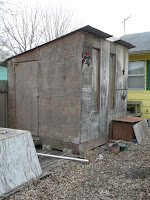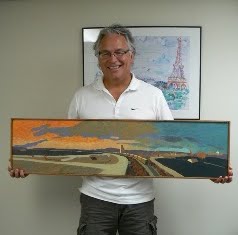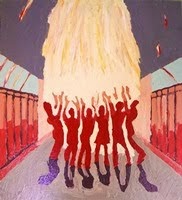In the new year 2012, I have been enjoying music by the tUnE-yArDs.
Watch video of
You Yes You, four minutes (above).
More works by Merill Garbus, click
HERE
More about her, click
HERE
http://www.tune-yards.com/
Watching her sing on stage reminds me of my second year in college.
Being an art student I put together and pulled off a few "free spirited events."

The year was 1975. I was enrolled in the
Centennial Educational Program, while at the University of Nebraska, in Lincoln.
One Saturday morning I staged an impromtu happening in the Nebraska Student Union lounge. My roommate Bob Winkler (above) and I stacked blocks of scrap wood and invited others to do the same.

This was what an art student with lots of zeal did when he was out on his own. The memories do not stop there.
Our dorm room on the second floor of
Love Hall became an art project itself. From the paper strips that hung from the ceiling (right) to the flattened refrigerator cardboard boxes
boxes I dragged from off-campus and lined our walls (left). To draw and build on, of course. Obviously influenced from the "basement wall" I grew up with in my parents' house. (See a clip of their wall, click
HERE.)
Friday nights when students were out visiting their friends on our floor, Bob and I talked fellow students to enter our room to see the hung ceiling and watch their response to it. That same year 1975, I had found a way to pull the paint layer out from our room wall. Very carefully I stuffed portions with small piece of tissue and resealed it (left and below).
Here is another memory about Centennial. That same year I organized, scripted and filmed a 40 minute
super-8 movie as an independent study
project at Centennial. The story followed a traveling salesman as he went from room-to-room with his suitcase. Each room presented a different odd scene. He met a scuba diver, a troupe of human flowers, a foosball champion, and many others. Fellow students in Centennial were asked for their ideas and many acted in the film. All the scenes were shot within Centennial. My advisor gave me full credit for it.
Centennial was in the (north) Love Hall end of the John G. Neihardt Residential Center. I remember setting up a number of "peoples concerts" to showcase the musical talent from our dorm and the Neihardt complex. I borrowed sound equipment from the Nebraska Union. There was a concert held in the Neihardt snackbar in the basement of our dorm, and one in the lounge of Raymond Hall, because it had a grand piano there. There was a concert also in the South Crib Room of the Nebraska Student Union. Here is a list of some of that talent. (I have added current available links where I could find them.)
Jon Swift on guitar,
Tim Roper 1 and 2 on violin,
Jeff Binder 1 and 2, Ray Walden on piano, Jim Williams on piano, Rick Nelson on guitar, Tim Booth on piano, Vicky Thomson on piano, Dave Mosley on piano, Steve Petersen on guitar, Pat Collins on guitar, Brian Nyquist vocals, Mark Willy on piano,
Bob Popek,
Jeff Taebel 1 and 2 on guitar
and 3,
Paul Marxhausen 1 and 2 on guitar, myself on piano, and others.

One more memory.
(below) That's me kneeling on pages torn

from

a discarded phone book. (In photo, Jon Swift is seated second from left, and Tim Roper seated just above my kneeling figure) In the darkened space Dan Swinarski (above, left) cast light on the dancing strips of paper for all to see.
With a free spirit and in total silence, the community watched and enjoyed the spontaneity of the event.











































